The Effects of Nonuniform Illumination on the Electrical Performance of a Single Conventional Photovoltaic Cell
Abstract
Photovoltaic (PV) concentrators are a promising approach for lowering PV electricity costs in the near future. However, most of the concentrators that are currently used for PV applications yield nonuniform flux profiles on the surface of a PV module which in turn reduces its electrical performance if the cells are serially connected. One way of overcoming this effect is the use of PV modules with isolated cells so that each cell generates current that is proportional to the energy flux absorbed. However, there are some cases where nonuniform illumination also exists in a single cell in an isolated cells PV module. This paper systematically studied the effect of nonuniform illumination on various cell performance parameters of a single monocrystalline standard PV cell at low and medium energy concentration ratios. Furthermore, the effect of orientation, size, and geometrical shapes of nonuniform illumination was also investigated. It was found that the effect of nonuniform illumination on various PV cell performance parameters of a single standard PV cell becomes noticeable at medium energy flux concentration whilst the location, size, and geometrical shape of nonuniform illumination have no effect on the performance parameters of the cell.
1. Introduction
Photovoltaic (PV) concentrators are devices that use mirrors, lenses, or solar reflectors to collect irradiation (both beam and scattered) from a large area and focus the intensity onto a small area so as to increase irradiation intensity on the surface of a solar cell/module [1]. Currently, PV concentrators are a promising approach for lowering PV electricity costs because optical devices are cheaper than replacing expensive solar cell/module [2]. However, most of the concentrators such as the Compound Parabolic Concentrators (CPCs) that are currently used for PV applications yield nonuniform flux profiles on the surface of a PV module which in turn reduces its electrical performance if the cells are serially connected. It is a well-known fact that, for a PV module with PV cells in series connection, its power output decreases depending on the cell(s) with the least illumination energy flux. One way of overcoming this effect is the use of PV modules with isolated cells so that each cell generates current that is proportional to the energy flux absorbed [3]. However, there are some cases where nonuniform illumination also exists in a single cell in an isolated cells PV module [4].
Early attempts to quantify the subject was taken by Pfeiffer and Bihler [5] who conducted a detailed indoor experimental test to investigate, amongst others, the effect of nonuniform illumination on the maximum power output of a concentrated Si PV cell. It was found that nonuniform illumination on a PV cell designed for concentrated light leads to only small losses (about 4%) in maximum power output. Another study was done by Cuevas and López-Romero [6] who examined the combined effects of nonuniform illumination and series resistance on the open-circuit voltage (VOC) of two Si PV cells: one with a very low series resistance and the other with a very high series resistance. One of the conclusions was that the decrease in VOC for cell with high series resistance was much higher than cell with very low series resistance, up to 30 mV for uniform illumination and up to 70 mV for nonuniform illumination. Chenlo and Cid [7] investigated the effect of both nonuniform illumination and nonuniform cell temperature distribution on the performance parameters of a PV cell in a linear PV concentrator. The cell used in this experiment was monocrystalline designed to be used with a concentrator and the current-voltage (I-V) curves of the cell were measured at uniform and nonuniform illumination profiles with concentration ratio of 24 and 63, respectively. Result indicated that there was a decrease in cell performance parameters at higher energy concentration. Franklin and Coventry [8] used both computer modelling and indoor experimental testing to investigate the effect of nonuniform distribution on the open-circuit voltage and cell efficiency of a PV cell designed for concentration ratio of approximately 30 suns. One of the conclusions was that the difference of VOC for uniform and nonuniform illumination was about 5 mV whilst the efficiency reduced from 17.3% for uniform illumination to 16.8% for nonuniform illumination. In addition to simulation, the authors also carried out an indoor experimental test on the same PV cell. It was found that, under uniform and nonuniform illumination profiles and constant cell temperature of 17°C, the short-circuit current was the same. However, a reduction in VOC of 7 mV was observed for nonuniform illumination. The cell efficiency was also observed to drop significantly, from an average of 20.9% for uniform illumination to 20.0% for nonuniform illumination.
All previous studies (except that of Cuevas and López-Romero [6]) have been carried out using PV cells which were designed to be used with concentrating systems. However, PV cells designed to be used with concentrating systems have low sheet resistance in the front layer, low base resistance, low resistance in the metal grids, low contact resistance between metal, and small grid shadowing [9]. As a consequence, the effect of nonuniform flux distribution is not critical, especially at low energy concentration. On the other hand, Cuevas and López-Romero [6] investigated the effect of nonuniform illumination only for one performance parameter: the open-circuit voltage.
The aim of this paper, therefore, was to systematically investigate the effect of nonuniform illumination on various performance parameters of a single monocrystalline standard PV cell at low and medium energy concentration ratios. Furthermore, the effect of orientation, size, and geometrical shapes of nonuniform illumination was also studied.
2. Materials and Methods
2.1. Physical and Electrical Characteristics of the PV Cell
To study the effects of nonuniform flux distribution on the performance parameters of a single PV cell, a series of indoor experimental tests were conducted using a multipurpose mobile solar simulator [10]. This multipurpose mobile solar simulator produces illumination with a good spectral match to AM 1.5 reference spectrum, uniformity of 95%, and an average collimation of 83% [10]. The PV cell used in this study was Bosch M 2BB monocrystalline PV cell with physical and electrical properties listed in Table 1 [11]. The effect of nonuniform illumination on the performance parameters of this cell was investigated at two different energy flux concentration ratios: low and medium, as described in detail in Sections 2.2.1 and 2.2.2, respectively.
| PV cell physical characteristics | |||||
|---|---|---|---|---|---|
| Dimensions | 156 mm × 156 mm (±0.5 mm) | ||||
| Average thickness | 200 μm (±40 μm) | ||||
| Front contacts (−) | 2 mm busbar (silver), textured, silicon nitride antireflective coating | ||||
| Back contacts (+) | 4.5 mm busbar (silver), full-surface aluminum BSF | ||||
| PV cell electrical characteristics | |||||
| VOC (mV) | ISC (mA) | VMPP (mV) | IMPP (mA) | PMPP (Wp) | η (%) |
| 616 | 8861 | 511 | 8270 | 4.23 | 17.50 |
| Temperature coefficients | α(ISC): +0.03%/K, β(VOC): −0.37%/K, γ(PMPP): −0.49%/K | ||||
2.2. Experimental Test Procedure
2.2.1. Experimental Test at Low Energy Flux Concentration
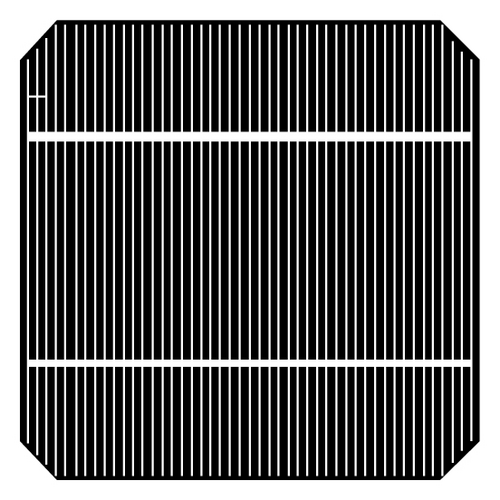
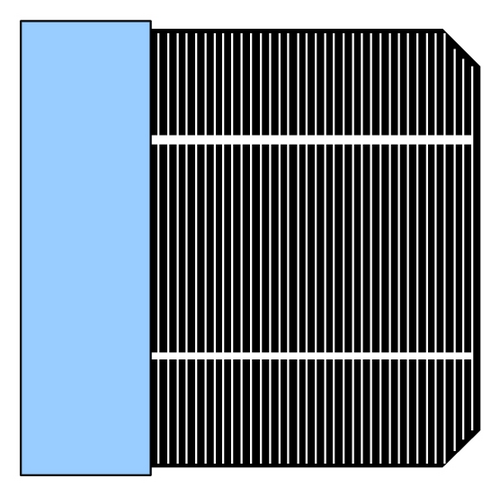
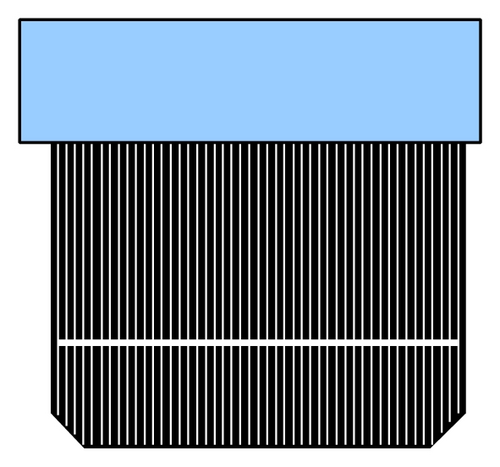
| Illuminated cell area (m2) | Irradiance on the active cell area (±20 W/m2) | Energy incident on the active cell area (W) |
|---|---|---|
| Full cell (uniform) (0.02347) | 804 | 18.87 |
| 75% along the grids (0.01760) | 1070 | 18.83 |
| 75% across the grids (0.01760) | 1070 | 18.83 |
During the experimental tests, irradiance on the surface of a PV cell, open-circuit voltage (VOC), short-circuit current (ISC), intermediate current and voltage, ambient temperature, and cell temperature were measured. The measurements for these parameters followed the same procedures as that described in [4], with the exception of irradiance that has to be adjusted for every experiment to ensure equal amount of incident energy. The illumination intensity on the surface of a PV cell was measured by a CM4 high temperature pyranometer with an error of ±20 W/m2 at 1000 W/m2 [4] while open-circuit voltage, short-circuit current, and intermediate current and voltage were measured by a Keithley 2430 Model SourceMeter with the voltage and current error of ±0.0080 V and ±0.0034 A [4], respectively.
2.2.2. Experimental Test at Medium Energy Flux Concentration
Results from experiment test one (effect of nonuniform illumination at low energy concentration ratio), as presented in Section 3.1, indicated that the performance of single conventional PV cell, at low energy flux concentration ratio and constant cell temperature, does not depend on the way the energy flux is distributed on the surface of a single standard PV cell. Thus, to examine if a PV cell at medium energy concentration ratio behaves in a different way, a second experimental test was conducted.
Since the maximum irradiance achievable by the solar simulator used in the first experiments was about 1300 W/m2 (at 1.45 m above the target), to obtain medium energy flux concentration on the PV cell, a symmetric 2-dimensional CPC and V-trough collectors were fabricated. The CPC had an acceptance half-angle (θa), entrance (Aa), and exit (Ar) apertures areas of 30°, 109 mm, and 218 mm, respectively, making a geometric concentration ratio (Cg) of 2.0. The CPC was truncated to a height of about 212 mm to reduce fabrication material cost [15]. For direct performance comparison, a choice was made to fabricate a V-trough with the same geometrical concentration ratio and aperture area as that of the symmetric CPC. Therefore, a V-trough with trough angle, ψ = 10°, was chosen to provide large acceptance at comparable size to the CPC. The V-trough collector had maximum height, slope height, entrance width (wa), and exit width (wr) of 296.7 mm, 301.3 mm, 109.0 mm, and 213.6 mm, respectively. Both concentrators were fabricated with high reflectivity anodised aluminium sheets with reflectivity of 0.90 [4].
Due to the nature of the illumination profiles in the CPC collector [3], the CPC was used to obtain nonuniform energy flux and medium energy concentration ratio whilst the V-trough collector was used to obtain low energy concentration ratio and uniform energy flux. For these experiments, the width of a PV cell used in experiment one was cut into 109 mm (using the FB1500 Laser Cutting Machine) to accommodate the base dimension of the CPC and V-trough collector. Figure 2 shows the photographs of the fabricated collectors (CPC and V-trough) and the PV cell under experimental test.


For comparison, the experimental test at medium concentration level was performed for two different energy concentration ratios. The first experiment was carried out when the peak energy concentration ratio for the CPC was 3 at θin = 0° and the second was performed when the peak energy concentration ratio for the CPC was 6 at θin = 20° (it should be noted that 20° incident angle was chosen because this is the incidence angle with the maximum CPC energy concentration ratio). Under both experiments, the V-trough collector was maintained at normal incidence angle to obtain uniform energy flux on the PV cell as illustrated in Figure 2(b).
Using (5) and the values of Gaperture(CPC), ηexp(CPC), and ηexp(V-trough, θin = 0°), the intensity on the aperture of a V-trough collector for the first and second experiments (medium energy concentration level) was determined. Table 3 shows the irradiance and energy flux at the aperture of the concentrator and on the surface of a PV cell for the CPC and V-trough collector for the two experiments.
| Type of the experiment | System description | Intensity on the aperture (±20 W/m2) | Energy on the aperture (W) | Intensity on the PV cell (±20 W/m2) | Energy at the PV cell (W) |
|---|---|---|---|---|---|
| Experiment number 1 (concentration ratio = 3) | CPC at θin = 0° | 600 | 20.00 | 541 | 18.46 |
| V-trough at θin = 0° | 595 | 19.83 | 541 | 18.75 | |
| Experiment number 2 (concentration ratio = 6) | CPC at θin = 20° | 551 | 18.36 | 506 | 17.76 |
| V-trough at θin = 0° | 557 | 18.56 | 506 | 17.76 | |
3. Results and Discussions
3.1. PV Cell Performances at Low Energy Concentration
Figure 3 shows a comparison of the I-V characteristics for a PV cell illuminated uniformly and nonuniformly. It can be seen that there are no significant differences between the two curves. The small discrepancy between the two curves is related to the repeatability of the measurements, especially setting the “current compliance limit” in each measurement to ensure that the measuring device (the Keithley 2430 SourceMeter) measures the correct value of ISC. It can be concluded, therefore, that, at low energy concentration ratio, nonuniform illumination does not have any effect on the I-V characteristic of a single standard PV cell. This can be explained by the fact that, at low energy flux concentration, the effect of shunt and series resistance, which results from nonuniform illumination, is negligible [17–19].
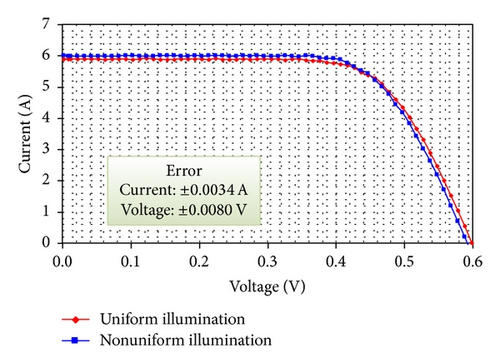
- (i)
Open-circuit voltage: the open-circuit voltage remains the same in both cases because it neither depends on the energy absorbed nor depends on the energy flux distribution, but only on saturation current and light generated current [9].
- (ii)
Short-circuit current: since the PV cell temperature was kept constant under both conditions (uniform and nonuniform illumination); the short-circuit currents generated by a PV cell under both conditions were the same for the reason that the cell received the same amounts of energy as shown in Table 2. In addition, due to low energy concentration, the effect of series resistance which results from uneven flux distribution effect is negligible [20]. It should be noted that, at constant temperature and low series resistance loss, short-circuit current is directly proportional to the absorbed energy [17, 21, 22].
- (iii)
Maximum power output: the internal series resistance losses on the PV cell occasionally are caused by nonuniform illumination. However, for low energy concentration, this effect can be considered negligible because internal series resistance losses increase with energy flux concentration and peak intensity [20]. Therefore, in Figure 3 there is no power output loss for nonuniform illumination condition which means that the power output is proportional to the absorbed energy as in the case of uniform illumination.
- (iv)
Fill factor: the main impact of series resistance is to reduce the fill factor [17]. The fact that the same FF was measured for uniform and nonuniform illumination conditions indicates that the internal losses under both conditions were the same and the effect of series resistance, due to nonuniform illumination, was negligible [17, 23].
- (v)
Electrical conversion efficiency: the conversion efficiency of a PV cell has been defined in (3) as the ratio of maximum power output to power input. While maximum power output of the PV cell depends on FF, VOC, and ISC, the input power varies with incident irradiance and cell area. The PV cell had equal input energy for both uniform and nonuniform illumination profiles as shown in Table 2, and from Figure 3, they have equal PMPP and therefore equal conversion efficiency.
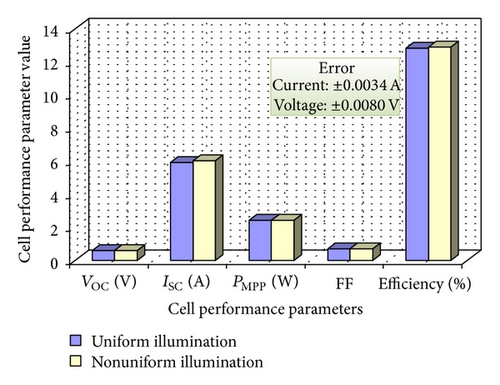
In addition to investigating the effect of nonuniform illumination on various cell performance parameters, the effect of nonuniform illumination location on cell performance parameters was also studied. This was done by placing an opaque material across the grids of the PV cell as shown in Figure 1(c). The result from this experiment was compared with the results from another nonuniform illumination location (of the same area) but introduced along the grids of the PV cell as in Figure 1(b). Table 4 shows the results from these experiments.
It can be seen that the location of nonuniform illumination (along or across the cell grids) in a single cell has no significant effect on the cell performance parameters. For cell performance parameters which are linearly dependent on the irradiance such as ISC and PMPP, the results observed in Table 4 can be explained by equal amount of energies that were received in both cases whilst for those parameters which are affected by series resistance (ISC and PMPP, FF, and η), equal values of nonillumination along the grids and across the grids were due to the fact that, at low energy concentration ratio, nonuniform illumination had very low series resistance which mean negligible effect on the parameters. For the VOC, the same values were measured for nonuniform illumination along and across the cell grids because the PV cell used in both experiments had the same physical properties. According to Andreev et al. [9], the VOC depends on the saturation current and light generated current which are controlled by the majority carrier concentration and electrophysical parameters (mobility and diffuse lengths) of the cell.
The results from these experiments regarding the effect of nonuniform illumination on different cell performance parameters contradict the previous published works of Pfeiffer and Bihler [5] and Franklin and Coventry [8]. In order to find out if increasing nonuniform illumination area may have an effect on the cell performance parameters, similar experiments as those in Table 2 were carried out. However, in this case the area covered by a black opaque material along and across the PV cell grids was increased to 50%. In each experiment, a full cell (illuminated uniformly) and a cell in which 50% of its area was uncovered by an opaque material had equal incident energy as shown in Table 5.
| Illuminated cell area (m2) | Irradiance on the active cell area (±20 W/m2) | Energy incident on the active cell area (W) |
|---|---|---|
| Full cell (uniform) (0.02347) | 600 | 14.08 |
| 50% along the grids (0.011735) | 1200 | 14.08 |
| 50% across the grids (0.011735) | 1200 | 14.08 |
Figure 5 shows the I-V characteristics for the PV cell under uniform and nonillumination. It can be seen that both I-V characteristics are the same, specifically in the low voltage region, implying that increasing nonuniform illumination area does not have any effect on the I-V curve of a single standard cell. The same conclusion can be made for the VOC, ISC, PMPP, FF, and η in Figure 6. This is in agreement with the results in Figure 4 when a nonuniform illumination occupied only 25% of the total cell area.
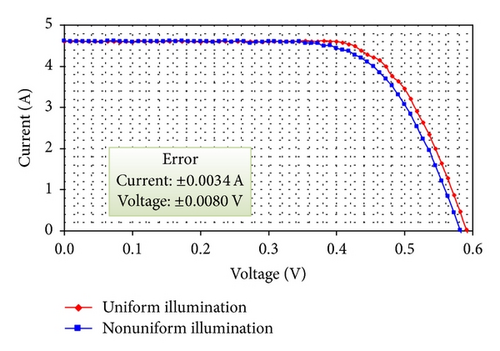

Table 6 shows the results of the experiments which were carried out to compare the performance of the PV cell under two different nonuniform illumination geometries (a square and a rectangle). The area covered by each geometrical shape was 50% of the total cell area. The square opaque material was place at the centre of the cell whilst the rectangular shape was placed along the grids of the PV cell. Since the energy incident on the PV cell under both cases was the same and the effect of series resistance was negligible (due to low energy flux concentration), it can be seen that there is no significant difference between VOC, ISC, PMPP, FF, and η for a square and a rectangular nonuniform illumination shape. The small difference observed in the cell performance parameters between the two geometrical shapes was attributed to imperfection in producing a square opaque material with exactly the required dimension of 110.3085 mm each side.
| Type of non-uniform illumination geometry | PV cell performance parameters | ||||
|---|---|---|---|---|---|
| VOC (±0.0080 V) | ISC (±0.0034 A) | PMPP (W) | FF | η (%) | |
| Square (110.3 mm × 110.3 mm) | 0.5637 | 4.8808 | 1.9063 | 0.6929 | 13.5372 |
| Rectangle (156 mm × 78 mm) | 0.5546 | 4.8847 | 1.8783 | 0.6934 | 13.3381 |
Furthermore, the effect of nonuniform illumination locations on the PV cell performance parameters of a single cell was studied in detail. The study was done by using two different geometry opaque materials: a square and rectangles. In each case, the area covered by a geometrical shape was 50% of the total cell area. The square opaque material was place at the centre of the cell whilst the rectangular shapes were placed along and across the grids of the PV cell at various positions as illustrated in Table 7. These combinations were chosen so that the results represent any type of nonuniform profile that occurs in real situation. It can be seen (from Table 7) that there is no significant different in VOC, ISC, PMPP, FF, and η for each of the investigated nonuniform illumination locations.
| Location of nonuniform illumination on the PV cell | PV cell performance parameters | ||||
|---|---|---|---|---|---|
| VOC (±0.0080 V) | ISC (±0.0034 A) | PMPP (W) | FF | η (%) | |
 |
0.5455 | 4.8831 | 1.8693 | 0.7018 | 13.2744 |
 |
0.5546 | 4.8847 | 1.8783 | 0.6933 | 13.3383 |
 |
0.5637 | 4.8808 | 1.9063 | 0.6929 | 13.5371 |
 |
0.5455 | 4.8831 | 1.8693 | 0.7018 | 13.2744 |
 |
0.5546 | 4.8865 | 1.9065 | 0.7035 | 13.5386 |
 |
0.5546 | 4.8847 | 1.8783 | 0.6933 | 13.3383 |
 |
0.5546 | 4.8865 | 1.9065 | 0.7035 | 13.5386 |
- (i)
The performance of a single conventional PV cell does not depend on the size and location of the nonuniform illumination.
- (ii)
The performance of a single conventional PV cell is independent of the geometrical shape of the nonuniform illumination.
3.2. PV Cell Performances at Medium Energy Concentration
Figures 7 and 8 illustrate the I-V characteristics of the PV cell under uniform and nonuniform illumination when the peak energy flux concentration was 3 and 6, respectively. Although the PV cell under uniform and nonuniform illumination had the same energy in each experiment and the cell temperature was kept constant, it can be seen that the I-V curve for uniform illumination was higher than that of nonuniform illumination in both experiments. This was attributed to series resistance effect which is higher under nonuniform illumination condition [20].
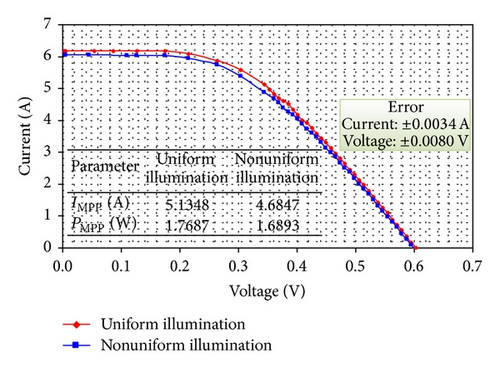
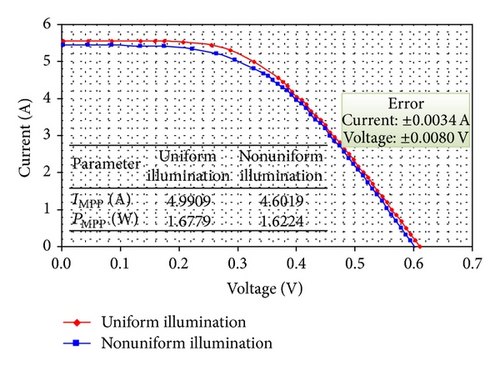
As shown in both Figures 7 and 8, there is a significant decrease in the I-V curve “sharpness” around the maximum power point for uniform and nonuniform illumination. This was due to voltage and current drop around the maximum power point. The voltage drop was due to the distributed diodes being at higher potential than the potential at the terminal while the current decrease was due to series resistance [17, 20]. The series resistance also reduced the maximum power output and this reduction increases with the increase in energy concentration ratio as illustrated in the inserted table in Figures 7 and 8. The nonuniform illumination for the PV module is illustrated in Figure 1(a) where there are two sharp energy peaks in the PV cell while the PV cell in the V-trough collector (Figure 1(b)), with the same amount energy, was uniformly illuminated. The sharp energy concentrations in Figure 1(a) resulted in higher current drops for a PV cell under nonuniform illumination than a PV cell under uniform illumination as illustrated in the inserted table in Figures 7 and 8.
Table 8 shows the variation in the PV cell performance parameters with energy illumination profiles for the two experiments. It can be seen that there is no difference in VOC for uniform and nonuniform illumination when the peak energy concentration was 3. However, the VOC slightly decreased (by about 1.3%) when the peak energy concentration in the nonuniform illumination increased from 3 to 6. This result can be explained as follows: under uniform illumination, VOC does not change even if the series resistance (RS) varies, because at short-circuit condition (ISC = 0) there are no current flows through the RS, which means that the voltage measured at the contacts equals the voltage at the diode junction. However, for the nonuniform illumination, there is an internal current flow from the highly illuminated region to the least-illuminated region [6]. This internal current flow produces a voltage drop across the series resistance of the cell which significantly affects the VOC. The decrease in VOC increases with increase in internal series resistance, increase in nonuniformity peak energy concentration, and increase in energy illumination level [6].
| Peak energy flux concentration for nonuniform illumination | Test condition | PV cell performance parameters | ||||
|---|---|---|---|---|---|---|
| VOC (±0.0080 V) | ISC (±0.0034 A) | PMPP (W) | FF | η (%) | ||
| 3 | Uniform illumination | 0.5950 | 6.1805 | 1.7687 | 0.4810 | 8.8791 |
| Nonuniform illumination | 0.5950 | 6.1340 | 1.6933 | 0.4640 | 8.4679 | |
| Decrease (%) | 0.0 | 0.8 | 4.3 | 3.5343 | 4.6311 | |
| 6 | Uniform illumination | 0.6031 | 5.5811 | 1.7023 | 0.5057 | 9.2517 |
| Nonuniform illumination | 0.5950 | 5.4546 | 1.6224 | 0.4999 | 8.8248 | |
| Decrease (%) | 1.3 | 2.3 | 4.7 | 1.1463 | 4.6143 | |
At low series resistance, the short-circuit current increases linearly with radiation intensity because it is a linear function of the light generated current which is proportional to the photon flux incident on the cell [17]. However, at sufficiently energy concentration (high current), the effect of RS becomes nonnegligible and the effect of nonuniform illumination becomes noticeable because the high local currents in part of the cell created by the peak intensity generate resistive losses. The short-circuit current loss as a result of series resistance increases with energy illumination level and peak energy flux concentration [18]. This is illustrated in Table 8 in which ISC for nonuniform illumination decreased by 0.8% and 2.3% when the peak concentration ratio increased from 3 to 6, respectively.
It can be observed from Table 8 that a PV cell under uniform illumination had higher power output and efficiency than a similar cell with nonuniform illumination, despite the fact that the cell had the same amount of energy under both cases (see Table 5). For example, at a peak energy flux concentration equal to 6, a reduction in PMPP of about 80 mW for nonuniform illumination was observed whilst the cell efficiency was observed to drop significantly, from about 9.25% to 8.82% for nonuniform illumination. The reason is that, at medium energy concentration, a PV cell under nonuniform illumination had higher internal series resistance than a similar cell under uniform illumination [18].
Similarly to ISC and PMPP, series resistance should reduce the FF of a cell under nonuniform illumination much more than a cell under uniform illumination. However, as shown in Table 8, the FF for a cell illuminated uniformly was only 2.4% higher than a similar PV cell under nonuniform illumination. The reason for this small difference is not clearly understood from this experiment. Further investigations are required to establish if this could be due to another factor(s).
4. Conclusions
- (i)
At low energy flux concentration ratio, nonuniform illumination does not have any effect on the I-V characteristic of a single standard PV cell because the effect of shunt and series resistance which results from nonuniform illumination is negligible.
- (ii)
There is no significant difference between open-circuit voltage, short-circuit current, maximum power output, fill factor, and conversion efficiency for uniform and nonuniform illumination profiles at low energy flux concentration ratio.
- (iii)
The performance of a single conventional PV cell does not depend on the location and size of the nonuniform illumination.
- (iv)
The performance of a single conventional PV cell is independent of the geometrical shape of the nonuniform illumination.
- (v)
The effect of nonuniform illumination on various cell performance parameters of a single standard PV cell becomes noticeable at medium energy flux concentration.
Conflict of Interests
The authors declare that there is no conflict of interests regarding the publication of this paper.




